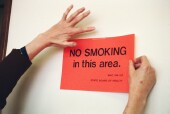
WEDNESDAY, Jan. 9 (HealthDay News) — North Carolina, a tobacco-growing state, does a lot to protect smoking: Its cigarette taxes are nearly the lowest in the country, and it only banned smoking in most restaurants, bars and hotels in 2010. But a newly reported survey suggests that its teenagers aren’t fans of tobacco.
More than 80 percent of 3,805 middle-school students surveyed said smoking shouldn’t be allowed at home, indoors at work or in cars. Slightly fewer (78 percent) of 3,301 high-school students were onboard with these restrictions, but most still liked not allowing smoking in homes and a few other places.
The surveys didn’t ask students about whether smoking in these areas should be legal. And, of course, they can’t vote until they’re 18, so their ability to push for change is limited, at least for a while.
Still, the results show that “it’s very clear, that teens and youth want to eliminate smoking in indoor and outdoor places,” said study co-author Leah Ranney, associate director at University of North Carolina at Chapel Hill’s Tobacco Prevention and Evaluation Program.
The researchers surveyed students in 2009. “They’re aware of the harmful effects of secondhand smoke exposure, and they understand the benefits of smoke-free policies,” Ranney said. “It tells you how effective our campaigns were. We are a tobacco-growing state, which makes it more challenging for us to successfully promote prevention of uptake of tobacco or cessation.”
Among the middle-school students, 86 percent supported never allowing smoking in indoor workplaces. The numbers for other places were: homes (84 percent), vehicles (82 percent), indoor public places (79 percent) and outdoor public places (63 percent).
Support for restrictions was slightly lower for high school students overall, and lowest for student smokers who did not want to quit. Among this group, 64 percent said smoking should never be allowed in homes. The numbers for other places were: vehicles (37 percent), indoor workplaces (61 percent), indoor public places (59 percent) and outdoor public places (30 percent).
Ranney said the results are similar to those from American and worldwide surveys. “Adult leaders need to listen to this and adopt policies to protect youth from secondhand smoke,” she said.
Danny McGoldrick, vice president of research at the Campaign for Tobacco-Free Kids, said smoking rates among teens have fallen by half since the 1990s, when they were skyrocketing.
According to federal figures, the percentage of high school students who said they smoked cigarettes within the last 30 days fell from 36 percent in 1997 to 20 percent in 2009.
Why? “We know increasing taxes reduces smoking, and we know that passing smoke-free laws does,” he said.
Cheryl Healton, president and CEO of the anti-smoking American Legacy Foundation, put it this way: “The price has gone up and the number of places you can smoke has gone down.”
The study appears in the Jan. 3 issue of the U.S. Centers for Disease Control and Prevention’s Preventing Chronic Disease.
More information
For more about teen smoking, try the U.S. National Library of Medicine.

